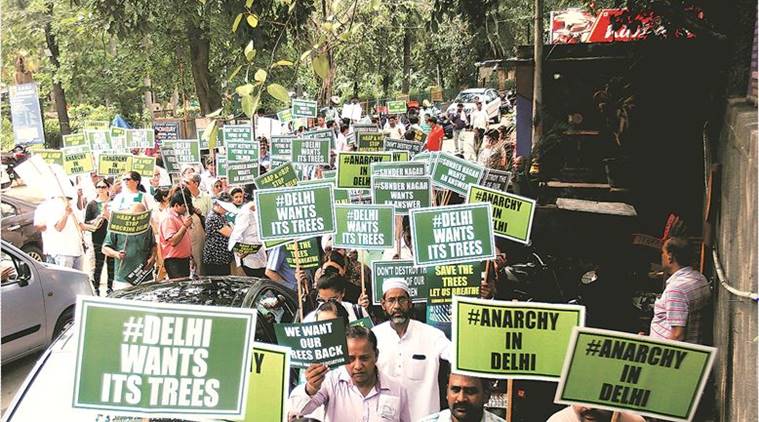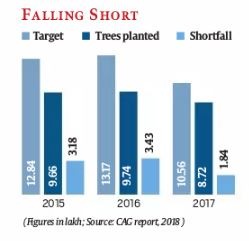 A protest against tree felling in Sundar Nagar on Friday. (Express photo)
A protest against tree felling in Sundar Nagar on Friday. (Express photo)
In the last seven years, the Delhi Forest Department has granted permission to cut at least 44,833 trees. But the figure does not include the proposal to chop close to 14,000 trees in south Delhi for redevelopment of seven government colonies. It was this move that, in a way, broke the camel’s back. With the decision being met with protests, the Ministry of Housing and Urban Affairs (MoHUA) ordered a redesign and declared that no more trees will be cut for the project, which has already seen 1,500 trees chopped this month.
“As stated earlier, no trees will henceforth be cut in the process of redevelopment of Delhi colonies,” announced Union Urban Development Minister Hardeep Singh Puri. According to Forest Department data, while the Delhi Metro and major road development and expansion projects have contributed to the loss in Delhi’s green cover over the past decade, the south Delhi infrastructure project was the largest in terms of impact on trees.

The National Buildings Construction Corporation (NBCC) Limited and the Central Public Works Department (CPWD) — agencies supposed to execute the redevelopment projects in Sarojini Nagar, Nauroji Nagar, Netaji Nagar, Thyagraj Nagar, Kasturba Nagar, Mohammadpur and Sriniwaspuri — had initially sought permission to cut close to 16,500 trees. After the Delhi Forest Department asked them to revise the project at Sarojini Nagar, wherein permission to cut 11,000 trees was sought, the number was brought down to around 14,000. This is a sizeable number when one considers that between 2011 and 2017, the South Division of the Forest Department, under which this current project area comes, gave permission to axe 13,860 trees.
The scale of this project meant that more trees would have been cut in a few months than those cut in six years under several Metro and road expansion projects. Experts and stakeholders The Indian Express spoke to said that while the government’s decision to tweak the south Delhi project is encouraging, several problems persist.
Transplantation
In a statement issued on Thursday declaring that no more trees will be cut for the project, the MoHUA had said: “The NBCC/CPWD will rework the design and plans for the remaining redevelopment of the seven GPRA colonies to avoid felling/cutting of trees. NBCC has already floated an Expression of Interest for acquisition of tree relocation/ transplantation equipment and for engaging services of trained professional entities.”
But transplanting trees is a process that requires expertise, time, patience and a lot of luck, said experts. According to ecologist C R Babu, technology to transplant trees does not always work. Moreover, transplanting old trees is always a risk due to stress and shock that a full-grown tree experiences when it is transplanted. “The chance of survival for old trees is 50-50,” he said. Even if a tree is successfully transplanted, it takes a minimum of 10 years to grow a full canopy, he added.

“Tropical trees, in any case, are not conducive to transplantation. These trees have deep roots because the water table is low. Most native trees, too, cannot survive the shock of having their roots cut or pared,” he said. According to Babu, while trees such as Peepal, Ficus, Semal and Sheesham are tolerant to transplantation, native trees such as Dak, Palash, Arjun, Shahtoot and Jhilmil are not.
How transplantation is done
* A ditch is dug around the tree and its root system is isolated from the soil.
* The big branches are lopped off, leaving a few small branches for regeneration.
* The root system is covered with wet gunny bags to protect the roots.
* The trees are then sent to a nursery to acclimatise.
* After the roots start growing back, the tree is lowered into a ditch created in its new spot.
After this process is complete, the tree requires months to settle in its new location and start growing new roots. New branches start to sprout if the tree is able to acclimatise, and if it is given enough care. Growing a full canopy takes around a decade. Babu, who was part of the team that transplanted peepal and ficus trees from Delhi University a few years ago, added, “It is also a very costly process. From start to finish, a full-grown tree with a big canopy can take up to Rs 1 lakh to isolate, transport, acclimatise, and transplant.”
Between 2011 and 2017, the Delhi Forest Department granted permission to transplant 6,041 trees. But the department does not have data on how many survived. Experts said the survival rate is usually between 5% and 20%. Suhas Borker, who founded the Green Circle of Delhi in 1992 and was part of the team that transplanted trees from the gate of Bada Gumbad in Lodhi Garden to a spot 50 feet away, is critical of the new plan. “The trees that grow in a particular area are acclimatised to its soil and weather conditions. Replanting them several kilometres away is too much of a shock for them,” said Borker.

According to Anchal Sodhi, who has completed close to 50 tree plantations so far, transplanting one tree can cost around Rs 4,000, and survival rate depends on the tree species. “If the tree is transplanted in winters, it has a good chance of surviving. In summers, it is not as easy. During monsoons, if there is waterlogging, it can harm the tree. For the right species of trees, transplantation can be very successful. Trees with tap roots cannot, however, be transplanted.”
Compensatory plantation
Along with the promise to transplant trees, Union Minister Puri has said that central agencies would plant 10 lakh trees this monsoon.
According to rules, for every tree that is cut, 10 have to be planted as compensation. The latest Comptroller and Auditor General (CAG) report says that between 2015 and 2017, the forest department was supposed to plant 65,090 trees. Instead, it managed to plant only 21,048 — a shortfall of 68%.
As per the report, reasons cited include a delay in acquiring land for plantation. “The reply is not acceptable as the (forest) department itself states that it asks the institutional agencies to provide 100% compensatory plantation land in case forest land is not available and, therefore, availability of land should have been ensured prior to giving permission for cutting trees,” said the report. Chief Conservator for Forests, Delhi, Nisheet Saxena refused to comment.
The report also castigates institutions that were supposed to meet compensatory plantation targets but did not. Agencies such as the NHAI, DMRC, NBCC, CPWD, DDA, PWD and municipal corporations cut 14,599 trees between 2014 and 2017. They were supposed to plant 1,07,326 trees as compensation, but the CAG report states that only 42,956 were actually planted — a deficit of 60%.
Moreover, the Forest Department could not meet its own target of planting 36.57 lakh trees between 2014 and 2017, and ended up planting 23% fewer trees. “The concept of compensatory plantation is inherently flawed. Patches of land available for plantation are usually the ones where the quality of soil is already poor. Otherwise, they would have been used for agriculture. On top of that, agencies are only interested in meeting plantation targets and stuffing as many trees as they can in a small patch,” said Pradip Krishen, author of Trees of Delhi, a book on the capital’s native trees.
But it isn’t just how much they plant that is important; there’s also the question of what they plant. Every region has native species of its own, which either originated in that area or has adapted over several hundred years. Over the past few years, different agencies have, however, tilted towards planting ornamental, exotic and non-native species.
Last month, the New Delhi Municipal Council came out with a list of trees it intends to plant during the monsoon — including peach and plum trees, which grow in colder climates. In the NBCC’s previous projects in New Moti Bagh and East Kidwai Nagar, trees such as bottle palm, royal palm, fan palm, ficus and plumeria were mostly planted. Ornamental in nature, these trees do not provide the thick canopy that most native trees do — which is important to battle air pollution.
At New Moti Bagh, of the 7,075 trees that NBCC planted, 116 were vilayati kikar, which is native to Mexico and is known to be so invasive that it wipes out other trees wherever it grows. “While the Delhi government and other agencies are trying to remove vilayati kikar from the Ridge, where it has wiped out almost all other trees, NBCC is planting this dangerous species in their project. It shows that either they have no knowledge about what needs to be planted or don’t care because vilayati kikar grows quicker,” said Faiyaz Khudesar, a scientist at Yamuna Biodiversity Park.
The red tape
Although Delhi has the second-highest tree cover as a percentage of total area among states, it doesn’t have a Forest Policy. Experts pointed out that in the absence of such a policy, which operates as a template for afforestation, Delhi had created the Greening Delhi Action Plan (GDAP) in 1997-98. But as per the CAG report, a new action plan hasn’t been created since 2007-08, while the Tree Authority of Delhi — the statutory body responsible for ensuring the protection of trees in the capital — has met only once since July 2013.
The Tree Authority of Delhi was set up under the Delhi Preservation of Trees Act (DPTA) 1994, and tasked with preserving and monitoring trees, as well as granting permission to prune and fell trees. But the CAG audit found that it had met once — as opposed to the DPTA mandate of meeting once every three months. “Against mandated 12 meetings, only one meeting was held during 2014-17, period covered in audit. Absence of regular meetings indicates lack of seriousness in its approach towards preservation of trees and afforestation,” said the report.